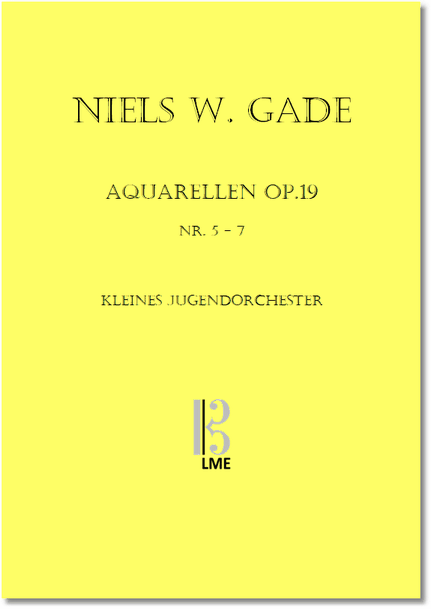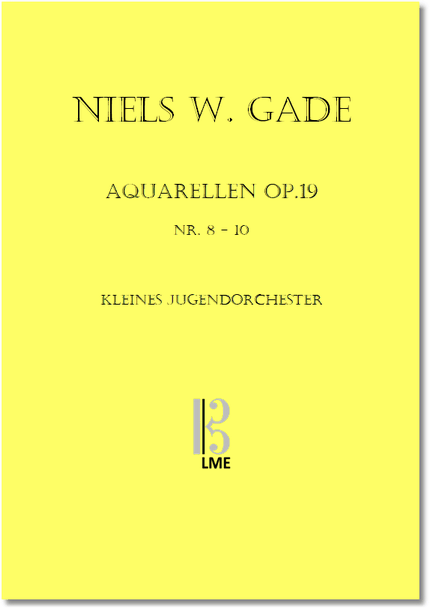Your more exceptional music publisher!
Home page New Editions 2020
New Editions 2020
GADE, Aquarellen op.19 no 5 - 7, youthorchestraProduct no.: 0536'Aquarellen' (= watercolours) by Niels Wilhelm Gade (composed 1850) are ten romantic, atmospheric pieces for piano of quite different character. In the present version for small youth orchestra the individual characteristics are clearly emphasized and set apart from each other. The original keys are partly changed, playing techniques are adapted to special techniques of the orchestra. |
GADE, Aquarellen op.19 no 8 - 10, youthorchestraProduct no.: 0537'Aquarellen' (= watercolours) by Niels Wilhelm Gade (composed 1850) are ten romantic, atmospheric pieces for piano of quite different character. In the present version for small youth orchestra the individual characteristics are clearly emphasized and set apart from each other. The original keys are partly changed, playing techniques are adapted to special techniques of the orchestra. |
MOZART, Mozart meets Beethoven, A Little Sinfonietta, youth orchestraProduct no.: 0494Whether both composers have met each other is questionable. When Beethoven came to Vienna in 1790 to introduce himself to Mozart as a new student, Mozart was probably travelling (Potsdam). When Beethoven finally moved to Vienna in 1792, Mozart had already died.
|
GRANADOS, A la cubana, youth orchestraProduct no.: 0520A short piano piece in Latin American mode for small youth orchestra. The catchy main theme and several episodes alternate. The strings dominate, the wind instruments create additional colour and contribute to the increase. Latin percussion instruments mark the rhythm and convey local colour. |
HOLST, Chaconne, from Suite No 1, youth orchestraProduct no.: 0524The original, the "First Suite in Eb for Military Band", was composed in 1909, making it one of the first and also most important works for the wind orchestra (26 voices & timpani and drums). |
BEETHOVEN, Für Elise, Piano piece aM WoO 59, EnsProduct no.: 0514Who does not know the little piano piece WoO 59 by Ludwig van Beethoven? In this arrangement you can play it with the whole students ensemble. The original key has been retained, the piano part corresponds to the original. Pedagogically suitable as an introduction to the theme: Classical, Rondo form. |
BEETHOVEN, Yorck March, EnsProduct no.: 0522March No. 1 in F major (WoO 18), known as the Yorcksch March or March of the Yorck Corps, is one of the most famous German military marches. Ludwig van Beethoven composed the piece in 1809 as "March for Archduke Anton" and renamed it in the same year as "Marcia No. 1 for the Bohemian Land Army". In 1813 the march was named in honour of the Prussian general Ludwig Yorck von Wartenburg (commander in the German wars of liberation). |
BEETHOVEN, Menuett, from Septett, EnsProduct no.: 0513The Septet in E flat major op. 20 was sketched in 1799 and premiered in the same year. The first edition, published in 1802, is dedicated to Empress Maria Theresa. The original instrumentation was expanded for a student ensemble, the key was made easier and some technically difficult passages were modified. |
BEETHOVEN, Rondino WoO 25, small youth orchestraProduct no.: 0512The original was probably composed in 1793 and was most likely intended as the final movement of the octet op. 103. In the instrumentation (2 Ob, 2 Kl, 2 Fg, 2 Hrn) the two natural horns are particularly striking: they are virtuosic, almost concertante. |
GRANADOS, Marche militaire, youth orchestraProduct no.: 0519Small character piece of enchanting intimacy, beyond the usual heroic march character. Effect through simplicity and retention of the essential elements of the genre. Not difficult to play, well suited for an orchestra in progress. |
BRAHMS, Fest- und Gedenksprüche op.109, Youth orchestraProduct no.: 0446The late, eight-part choral work in a version for youth orchestra. Brahms refers to the multi-choral compositions of the early baroque period (Venetian era). The dense, imitative movement stands for seriousness and solemnity. The transfer to the instruments of the orchestra lends colour to the voices and structures the work. 1. Unsere Väter - 2. Wenn ein starker 02:20 - 3. Wo ist ein so herrlich Volk 04:50 can be shipped within 1 - 3 days |
GLUCK, Entry of the priests, from Alceste, youth orchestraProduct no.: 0445A beautiful piece of sound with a solemn character. Quite easy to play, well suited for a youth orchestra in the beginning or build-up. |
BEETHOVEN, Hirtengesang, from symphony No.6, youth orchestraProduct no.: 0511Beethoven's 6th Symphony pastorale is one of the most popular works of the composer. Here is an arrangement of the 5th movement, which retains most of the original key and setting. Facilitations and some additional instruments make the piece playable for your orchestra! can be shipped within 1 - 3 days |
ELGAR, Pomp & Circumstance Nr.1, youth orchestraProduct no.: 0442This march from 1901, which Edward VII wanted for his coronation celebrations, is underlaid with the words "Land of Hope and Glory" and became almost more popular than the official British national anthem God Save the Queen (King). Here is a version for youth orchestra, whose instrumentation is based on the original. Some parts have been combined, others added. All in all, the piece is relieved, but does not lose any of its outstanding tonal effect. can be shipped within 1 - 3 days |
FAURE, Masques et Bergamasques, Ouverture, youth orchestraProduct no.: 0507The first of the four instrumental pieces of the one-act stage work of the same name, which was premiered in April 1919. The present version for youth orchestra retains the key, facilitates some instrumental parts and expands the sound space by adding more instruments. The cheerful, light character was adopted. can be shipped within 1 - 3 days |
ELGAR, Pomp & Circumstance Nr.4, youth orchestraProduct no.: 0443The March was first performed on 24 August 1907 at Queen's Hall, London, under the composer's direction. can be shipped within 1 - 3 days |
No VAT after § 19 UStG
| 31 - 46 of 46 results |
|




















